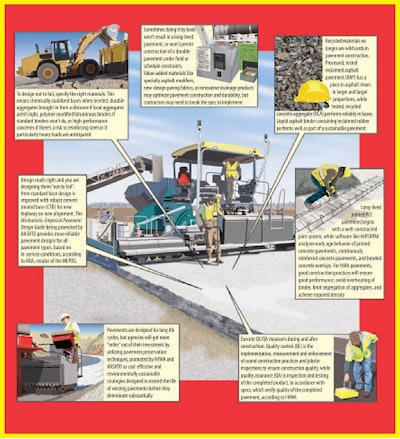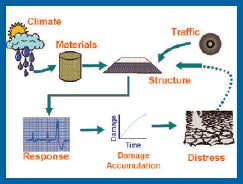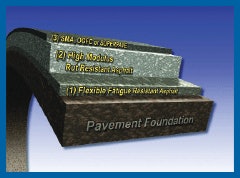
Design durable roads and you are designing them “not to fail.”
A variety of tools now exists that civil engineers can use to design pavements that will stand up to traffic and the elements, optimizing long-term expenses while minimizing disruption to the motoring public.
• Life-cycle cost analyses (LCCA) permit engineers and agency owners to evaluate alternative infrastructure design options for optimal long-term investment.
• The Mechanistic-Empirical Pavement Design Guide being promoted by the American Association of State Highway and Transportation Officials (AASHTO) provides more reliable pavement designs for all pavement types, based on in-service conditions.
• The asphalt perpetual pavement philosophy provides a path to deep asphalt pavements that resist fatigue cracking while ultimately permitting easy removal and replacement of stressed driving courses after they have served their missions.
Also, grooved next-generation concrete surface (NGCS) pavements now exist for quieter travel, increased friction and improved ride, even as high-performance concrete (HPC) made from ternary blends of cement-enhanced durability. Value-added materials such as polymer modifiers for asphalt pavements, and chemical admixtures for concrete, make those paving media construct faster and last longer.

FAILPROOF
roadbuilding IV
Field Operations
Recycled materials have become a major component of sustainable pavement design, providing a real benefit to society while giving a defense against attacks by the Green movement. And in an age of reduced funding, the philosophy of pavement preservation provides a pathway to extended pavement life, so long as the pavements are well-constructed to begin with, and the preservation treatment is applied at the right point in a pavement’s life cycle.
Even as new materials and new philosophies of pavement engineering for longer life structures proliferate, it’s instructive to note that it’s a clear reversal of how the Interstate system came to be.
Beginning in 1956, when Interstate highways began to be designed and built, deep-section pavements were discouraged, and the program goal was to put down pavement as fast as possible, toward a goal of total system completion by 1975. Today’s themes of spending more up front for longer-term performance, contractor design and warranties, and contractor-certified quality acceptance were either strongly discouraged, or actually illegal.
The program operated under very tight, top-down supervision of pavement design and specs, with the Federal Highway Administration reviewing and approving every pavement design. Because the intent of Congress was to complete 42,000-mile Interstate system by 1975 – in only 19 years – the federal emphasis was on laying down as much highway as possible.
Back then maintenance was to be the complete responsibility of the states. FHWA engineers reviewed all pavement designs to make sure states were not placing more robust pavement designs than needed to complete the system in time. Because deeper pavements reduced future state maintenance costs, it was perceived that federal funds were being used to defer maintenance spending at the expense of other states and timely completion of the system.
Life-Cycle Costing Evolves
For more than two decades, the concepts of pavement life cycle cost analysis – and now, life-cycle assessment – have influenced design of both flexible (asphalt) and rigid (concrete) pavements. Proponents of each paving medium have developed rationales for LCCA favoring use of one over the other, sometimes generating rancor.
What is not arguable is that LCCA is a process of selecting the most economical pavement design based on initial construction costs and future maintenance, rehabilitation and reconstruction costs.
LCCA is a process for evaluating transportation project expenditures. “LCCA will assist in determining the best – the lowest-cost – way to accomplish the project,” says FHWA’s Life Cycle Cost Analysis Primer (2002). The five steps to LCCA, according to the primer, are
• Establish design alternatives.
• Determine activity timing.
• Estimate costs (agency and user).
• Compute life cycle-costs, and
• Analyze the results.
Significantly, best-practice LCCA calls for including not only direct agency expenditures (for example, construction or maintenance activities), but also costs to facility users that result from these agency activities.
“The predicted schedule of activities and their associated agency and user costs form the projected life-cycle cost (LCC) stream for each design alternative,” FHWA says. “Using an economic technique known as ‘discounting,’ these costs are converted into present dollars and summed for each alternative. The analyst can then determine which alternative is the most cost-effective.”
FHWA notes the lowest LCC option may not necessarily be implemented when other considerations such as risk, available budgets, and political and environmental concerns are taken into account, adding “LCCA provides critical information to the overall decision-making process, but not the final answer.”
Although LCCA was only officially mandated in a very limited number of situations, FHWA has always encouraged the use of LCCA in analyzing all major investment decisions where they are likely to increase efficiency and effectiveness.
However, the 1998 Transportation Equity Act for the 21st Century (TEA-21) removed the requirement for state highway agencies to conduct LCCA on high-cost NHS useable project segments.
But the philosophy lives on. A 2011 National Cooperative Highway Research Program project – NCHRP No. 703: Guide for Pavement Type Selection (Google NCHRP No. 703) – surveyed state transportation agencies and reported that 29 of 35 states that responded use LCCA for new construction or reconstruction projects.
Because there is no current requirement that LCCA be conducted or used to select among pavement types used on federally funded highway projects, federal LCCA guidance and assistance to state transportation agencies is advisory.
Beginning in August 2012 – in an effort to shine a light on a process that could cause federal funds to be spent more wisely, and to fulfill a mandate of MAP-21 – the Government Accountability Office (GAO) looked closely at use of LCCA among the states.
The result is the June 2013 report, Improved Guidance Could Enhance States’ Use of Life-Cycle Cost Analysis in Pavement Selection (Google GAO-13-544). GAO visited four states to interview local FHWA, state DOT and asphalt and concrete pavement industry association representatives, and conducted telephone interviews with state transportation agency officials in 12 more states. Selection criteria includes a wide range of LCCA approaches and a wide geographical distribution of states.
GAO found a mixed bag, with no great lessons to learn. “Information gathered from these states is not generalizable to all states,” GAO reports. “States’ life-cycle cost analysis practices vary, though they are often informed by FHWA guidance. Most of the selected states we reviewed use LCCA in some capacity to help ensure the long-term cost-effectiveness of investment decisions.
“Thirteen of 16 states included in our review used it in some capacity,” GAO says. “State transportation officials in [those] 13 states indicated that the goal of LCCA was to help ensure that the agency makes long-term, cost-effective investment decisions. Some state officials also noted that LCCA could help the state transportation agency communicate to stakeholders – pavement industry representatives, state legislators, and taxpayers – that it is making sound decisions.”
Mechanistic-Empirical Design
Even as LCCA evolves, with a strong shove by AASHTO, the “hands on” mechanistic-empirical design philosophy is taking root in road agencies from coast to coast.
 Mechanistic-empirical pavement design considers site conditions such as traffic, climate, subgrade, existing pavement condition for rehabilitation, and construction conditions, in proposing a trial design for a new pavement or rehab; then, using software, the trial design is evaluated through prediction of key distresses and smoothness.
Mechanistic-empirical pavement design considers site conditions such as traffic, climate, subgrade, existing pavement condition for rehabilitation, and construction conditions, in proposing a trial design for a new pavement or rehab; then, using software, the trial design is evaluated through prediction of key distresses and smoothness.The Mechanistic-Empirical Pavement Design Guide, Interim Edition: A Manual of Practice provides more reliable pavement designs for all pavement types, based on in-service conditions, according to ARA, creator of the MEPDG. The guide and associated software – now in various stages of adoption throughout the state DOTs – provide a state-of-practice mechanistic-empirical highway pavement design methodology based on actual experience from the real world, translated to a design program (see “To Prevent Failure, Begin with Better Bases,” May 2013, pp. 20-27).
Pavement ME Design is the next generation of AASHTOWare pavement design software, which builds upon the mechanistic-empirical pavement design guide, and expands and improves the features in the accompanying prototype computational software.
Using real-world conditions, the MEPDG represents a major change in the way pavement design will be performed, and in a way, is not unlike of the Superpave system of performance-based mix design specs.
Mechanistic-empirical are big words that describe a very simple concept. “Mechanistic” refers to the interaction between the materials and structure of a pavement, and its stresses and strains under load deflection. The concept relates pavement mechanics to “empirical” or experimental performance data obtained in field or lab.
The MEPDG uses mathematical models to describe this relationship, and the primary basis for all mechanistic-based pavement performance predictions methods is cumulative axle load applications. The former (1993) edition of the AASHTO Guide for Design of Pavement Structures was based totally on empirical equations derived from the famous, but outdated, AASHO Road Test. That test involved field testing between 1958 and 1960 of a limited number of structural sections at one location, Ottawa, Ill., and with much-reduced traffic levels compared those of the 21st century.
 Asphalt perpetual pavement design calls for deep, robust, fatigue crack-resistant layers of asphalt, of different mix formats, topped with a sacrificial friction course that can be periodically milled and overlaid.
Asphalt perpetual pavement design calls for deep, robust, fatigue crack-resistant layers of asphalt, of different mix formats, topped with a sacrificial friction course that can be periodically milled and overlaid.Under the new design guide, a designer of any pavement must first consider site conditions such as traffic, climate, subgrade, existing pavement condition for rehabilitation, and construction conditions, in proposing a trial design for a new pavement or rehab. Then, using the software, the trial design will be evaluated through prediction of key distresses and smoothness. If the trial does not meet the demanded performance criteria, the pavement design must be revised until it does.
The mechanistic-empirical format of the design guide adapts it to evolution in truckloads, materials, construction techniques, design concepts and even computerization. It’s a forward-looking methodology that will take the industry away from the “cookbook” or “recipe” specifications and design methods of the Ottawa tests, and into a future that molds design to anticipated performance.
“The benefit of a mechanistic-empirical approach is its ability to accurately characterize in situ material (including subgrade and existing pavement structures),” says the Washington State DOT in its online tutorial. “This is typically done by using a portable device (like a falling weight deflectometer to make actual field deflection measurements on a pavement structure to be overlaid. These measurements can then be input into equations to determine existing pavement structural support (often called ‘backcalculation’) and the approximate remaining pavement life. This allows for a more realistic design for the given conditions.”
The MEPDG continues to be fine-tuned. For example, the June GAO report on LCCA affirmed that it “must be calibrated for conditions in individual states because, for example, the same design may perform differently in different climatic conditions and differently based on the available construction materials and stone in the state.”
And in March 2012, a critique of the MEPDG – AASHTO Mechanistic-Empirical Pavement Design Guide Parametric Study by Ruipeng Li and Steven Cramer, University of Wisconsin-Madison, for the National Center for Freight and Infrastructure Research and Education – found the MEPDG had limitations in that it did not account for the effects of supplementary cementitious materials on the pavement design, and it erroneously restrained the permissible range for concrete modulus of rupture input due to thermal stress on jointed plain concrete pavement.
ME principles are being adopted in other ways. For example, as of October 2012, the Minnesota DOT permits the ACPA’s StreetPave software to be used for jointed concrete pavement design as an alternative to its existing MnDOT RigidPave software, with the exception of concrete pavement projects within trunk highway rights-of-way, which must continue to use RigidPave.
That’s significant because the design method used in StreetPave is based on the Portland Cement Association (PCA) thickness design method, incorporating results from the empirical 1954 AASHO Road Test, more recent information from mechanistic-empirical studies, and a newly updated fatigue model, MnDOT says.
Perpetual Pavements
The asphalt perpetual pavement reflects mechanistic design, but also is suited for long-term pavement preservation, as the design calls for deep, robust, fatigue crack-resistant layers of asphalt, of different mix formats, topped with a sacrificial friction course that can be periodically milled and overlaid, likely at night to reduce impact to motorists.
The perpetual pavement concept was first articulated in 2000 by the Asphalt Pavement Alliance (APA), a joint promotional effort of The Asphalt Institute, NAPA, and the State Asphalt Pavement Associations, representing local contractor associations in 36 states.
A perpetual pavement is defined by APA as an HMA pavement designed and built to last longer than 50 years without requiring major structural rehabilitation or reconstruction, and needing only periodic surface renewal in response to distresses confined to the top of the pavement.
Perpetual pavement’s increased durability is a product of mechanistic design, instead of long-standing empirical design. Its mechanistically based pavement design incorporates how traffic stresses induce strain that will affect the pavement’s performance, taking into account material qualities and thickness.
By contrast, an empirical design would take the results of existing experience, in the industry’s case, the AASHO Road Tests, and make the design conform to a test design that successfully withstood loadings that mirror those anticipated for the new construction.
By designing the pavement to keep strain below the critical level, fatigue failure is avoided and perpetual performance can be assured, proponents say, adding structural and aeronautical engineers have used mechanistic design principles for years.
Another approach to ensure long-term fatigue life is to design a thickness for a stiff structure so the tensile strain at the bottom of the asphalt layers is insignificant. This allows for the use of a single mix design in the base and intermediate layers, and precludes the need to change mix types in the lower pavement structure.














